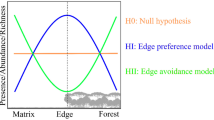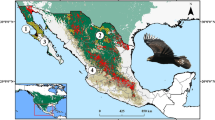Abstract
In 2016 and 2017, from April to July, bird individual nesting home ranges were regularly mapped along the permanent census route (2.8 km) in the low-mountain forests dominated by pine and birch. For each bird species, the nesting densities and average sizes of the bird individual nesting home range were estimated, and raster maps of spatial allocation (MSA) at the scale of the raster grid of 50 × 50 m were obtained. The degree of spatial conservatism (DSC) for each local population was inferred from the pairwise comparisons of the specific MSAs obtained at the same area (28 ha) in different years with the use of the Gamma rank correlation method. The statistical dependence of the population habitat area on DSC was demonstrated earlier (Cherenkov, 2017). The more habitat area is found within the trial plot, the less dependent (random) the individual spatial allocation within a population is observed in different years. Significant DSC estimates (p < 0.05) were obtained for 15 species, and their habitat areas and habitat saturation were found. The population status was inferred from the degree of habitat saturation. Average estimates of the degree of habitat saturation were close in migratory and nonmigratory species (49 and 45%, respectively). The Altai migratory birds wintering in Southeast Asia did not differ statistically in the degree of habitat saturation from those wintering in Southern Europe and North Africa. A comparison of avifauna status of the Altai and Baikal regions revealed substantial differences. In Altai the number of the most common migratory nesting species is almost twice as high, their average nesting density is four times higher, and habitat saturation is twice as high as in the birds of the Baikal region. The interregional differences in the degree of habitat saturation indicate that most of populations of the migratory species of the Baikal region are subject to twice as much intensive pressure of some factors limiting the population growth compared to the Altai populations. At the same time, there were no significant differences in the ecological population status of the nonmigratory species between these regions. Close estimates of the degree of habitat saturation in nonmigratory species in the Altai and Baikal regions support a suggestion that the integrate influence of factors limiting their population numbers is similar in both regions. Close estimates of the degree of habitat saturation and nesting density in the migratory and nonmigratory Altai species show that neither of the two strategies of surviving gives a pronounced advantage. The difference between the Altai and Baikal regions in the degree of habitat saturation in the migratory species is seemingly determined by the different mortality levels in the wintering areas and on the routes of migrations.





Similar content being viewed by others
REFERENCES
Ananin, A.A., Long-term dynamics of abundance of background species of birds of Barguzin Ridge during nesting, Vestn. Buryat. Gos. Univ., Biol. Geogr., 2011, no. 4, pp. 93–99.
Baranov, A.A., Ptitsy Altai-Sayanskogo ekoregiona: prostranstvenno-vremennaya dinamika bioraznoobraziya. Monografiya (Birds of Altai-Sayan Ecological Reigon: Spatio-Temporal Dynamics of Biological Diversity: Monograph), Krasnoyarsk: Krasnoyarsk. Gos. Pedagog. Univ., 2012, vol. 1.
Burskii, O.V., Long-term study of the bird community, Materialy Rossiiskogo soveshchaniya “Dinamika chislennosti ptits v nazemnykh landshaftakh,” Moskva, 21–22 fevralya 2007 g. (Proc. Ross. Sci. Meeting “Dynamics of Bird Population in Terrestrial Landscapes,” Moscow, February 21–22, 2007), Moscow: Inst. Probl. Ekol. Evol., Ross. Akad. Nauk, 2007, pp. 25–38.
Cherenkov, S.E., An approach to evaluating ecological status of populations in forest-nesting birds (Passeriformes and Piciformes), Contemp. Probl. Ecol., 2017, vol. 10, no. 3, pp. 203–214.
Cherenkov, S.E., Faunistic composition, phenology, and nesting density of birds in dark coniferous forest on the northern slope of the Khamar-Daban Ridge, Russ. Ornitol. Zh., 2018, vol. 27, no. 1616, pp. 2503–2524.
Cherenkov, S.E., The faunal composition, phenology and nesting density of birds in low-mountain forests of the lower course of the Sema River (Altai Republic), Russ. Ornitol. Zh., 2019a, vol. 28, no. 1742, pp. 1089–1129.
Cherenkov, S.E., Ecological status of populations of the most common bird species in the dark-coniferous taiga of Baikal, Contemp. Probl. Ecol., 2019b, vol. 12, no. 3, pp. 231–237.
Ermakov, N.B., Pine forests of Altai Mountains, Cand. Sci. (Biol.) Dissertation, Novosibirsk: Tsentr. Sib. Bot. Sad, Sib. Otd., Akad. Nauk SSSR, 1988.
Fefelov, I.V., Tupitsyn, I.I., Podkovyrov, V.A., and Zhuravlev, V.E., Ptitsy del’ty Selengi (Birds of the Selenga River Delta), Irkutsk: Vost.-Sib. Izd. Kom., 2001.
Gashkov, S.I., Biology of the great tit (Parus major L.) from southern taiga of Western Siberia, Extended Abstract of Cand. Sci. (Biol.) Dissertation, Tomsk: Tomsk State Univ., 2007.
Grazhdan, K.V., Ravkin, Yu.S., Toropov, K.V., and Mitrofanov, O.B., Long-term changes in the bird population of Northeastern Altai, Materialy Mezhdunarodnoi konferentsii “Ekologiya i ratsional’noe prirodopol’zovanie na rubezhe vekov. Itogi i perspektivy,” Tomsk, 14–17 marta 2000 g. (Proc. Int. Conf. “Ecology and Rational Nature Management in the Turns of Centuries: Results and Prospects,” Tomsk, March 14–17, 2000), Tomsk: Tomsk. Gos. Univ., 2000, vol. 2, pp. 41–43.
Kamp, J., Oppel, S., Ananin, A.A., Durnev, Y.A., Gashev, S.N., Hölzel, N., Mishchenko, A.L., Pessa, J., Smirenski, S.M., Strelnikov, E.G., Timonen, S., Wolanska, K., and Chan, S., Global population collapse in a superabundant migratory bird and illegal trapping in China, Conserv. Biol., 2015, vol. 29, pp. 1684–1694.
Khokhlova, T.Yu., Interspecific competition among secondary hollow nests in conditions of sharp interannual shifts of spring temperatures in Karelia, Prints. Ekol., 2014, no. 3, pp. 49–65.
Koblik, E.A., Red’kin, Ya.A., and Arkhipov, V.Yu., Spisok ptits Rossiiskoi Federatsii (The List of Birds of Russian Federation), Moscow: KMK, 2006.
Odum, E.P., Fundamentals of Ecology, Philadelphia: W.B. Saunders, 1953.
Paevskii, V.A., Demograficheskaya struktura i populyatisonnaya dinamika pevchikh ptits (Demographic Structure and Population Dynamics of Songbirds), Moscow, 2008.
Paevskii, V.A., Stationary long-term capture-recapture studies in population ecology of birds, Russ. Ornitol. Zh., 2010a, vol. 19, pp. 659–670.
Paevskii, V.A., Breeding biology, morphometrics and population dynamics of Sylvia warblers on the Curonian Spit, Eastern Baltic, Russ. Ornitol. Zh., 2010b, vol. 19, pp. 1783–1799.
Priednieks, Ya., Kuresoo, A., and Kurlavichyus, P., Rekomendatsii k ornitologicheskomu monitoringu v Pribaltike (Recommendations for Ornithological Monitoring in the Baltic Region), Riga: Zinatne, 1986.
Priednieks, Ya., Strazds, A., and Petrin’sh, A., Atlas gnezdyashchikhsya ptits Latvii 1980–1984 (Atlas of Nesting Birds of Latvia, 1980–1984), Riga: Zinatne, 1989.
Ravkin, Yu.S., Ptitsy Severo-Vostochnogo Altaya (Birds of the Northeastern Altai), Novosibirsk: Nauka, 1973.
Ravkin, E.S. and Ravkin, Yu.S., Ptitsy ravnin Severnoi Evrazii. Chislennost’, raspredelenie i prostranstvennaya orgnaizatsiya soobshchestv (The Birds of the North Eurasian Plains: Population, Distribution, and Spatial Organization of Communities), Novosibirsk: Nauka, 2005.
Rogacheva, E.V., Ptitsy Srednei Sibiri (Birds of Central Siberia), Moscow: Nauka, 1988.
Samoilova, G.S., Landscape structure of physical-geographic regions of the Altai Mountains, in Voprosy geografii. Sb. 121. Landshaftovedenie: teoriya i praktika (Problems of Geography, No. 121: Landscape Science: Theory and Practice), Moscow: Mysl’, 1982, no. 121, pp. 154–164.
Samplonius, J.M. and Both, C., Climate change may affect fatal competition between two bird species, Curr. Biol., 2019, vol. 29. pp. 327–331.
Shoba, S.A., Dobrovol’skii, G.V., Alyabina, I.O., Urursevskaya, I.S., Chernova, O.V., and Bushneev, A.N., Natisonal’nyi atlas pochv Rossiiskoi Federatsii (National Atlas of Soils of Russian Federation), Moscow: AST, 2011.
Shutov, S.V., Nesting density of common species of passerines (Passeriformes) in the Subpolar Urals and its spatial change in the floodplains of the southern Subarctic, Zool. Zh., 1990, vol. 69, no. 5, pp. 93–99.
Sokolov, L.V., Global warming and dynamics of migratory bird populations in Europe, Materialy Rossiiskogo soveshchaniya “Dinamika chislennosti ptits v nazemnykh landshaftakh,” Moskva, 21–22 fevralya 2007 g. (Proc. Ross. Sci. Meeting “Dynamics of Bird Population in Terrestrial Landscapes,” Moscow, February 21–22, 2007), Moscow: Inst. Probl. Ekol. Evol., Ross. Akad. Nauk, 2007, pp. 8–24.
Sushkin, P.P., Ptitsy Sovetskogo Altaya i prilezhashchikh chastei Severo-Zapadnoi Mongolii (Birds of Soviet Altai and Adjacent Parts of Northwestern Mongolia), Moscow: Akad. Nauk SSSR, 1938, vol. 2.
Tomiałojć, L., The combined version of the mapping method, Proc. VI Int. Conf. on Bird Census Work “Bird Census Work and Nature Conservation,” Göttingen: Univ. of Göttingen, 1980. pp. 92–106.
Tomiałojć, L. and Stawarczyk, T., Awifauna Polski: Rozmieszczenie Liczebność i Zmiany, Wrocław: pro Natura, 2003, vol. 2.
Toropov, K.V. and Grazhdan, K.V., Ptitsy Severo-Vostochnogo Altays: 40 let spustya (Birds of Northeastern Altai: 40 Years Later), Novosibirsk: Nauka, 2010.
Tsybulin, S.M., Ptitsy Severnogo Altaya (Birds of Northern Altai), Novosibirsk: Nauka, 1999. Ventsel’, E.S., Teoriya veroyatnostei: Uchebnik dlya vuzov (The Theory of Probability: Manual for Higher Education Institutions), Moscow: Vysshaya Shkola, 1999, 6th ed.
Zimin, V.B., Sazonov, S.V., Lapshin, N.V., Khokhlova, T.Yu., Artem’ev, A.V., and Annenkov, V.G., Ornitofauna Karelii (Ornithological Fauna of Karelia), Petrozavodsk, 1993.
ACKNOWLEDGMENTS
This study was supported by the Gorno-Altaisk Botanical Garden of the Altai Branch, Central Siberian Botanical Garden, Siberian Branch, Russian Academy of Sciences. I am very grateful to its directors E.V. Banaev and A.A. Achimova and officers M.B. Yamtyrov, L.V. Kazantseva, and T.P. Krupina; without their organizational and friendly support, this work would have been impossible.
I am sincerely grateful to my friends A.S. Golubtsov and A.V. Filchagov for their support and assistance in the work.
Author information
Authors and Affiliations
Corresponding author
Ethics declarations
Conflict of interests. The authors declare that they have no conflicts of interest.
Statement on the welfare of humans or animals. This article does not contain any studies involving animals performed by any of the authors.
Additional information
Translated by L. Solovyova
Rights and permissions
About this article
Cite this article
Cherenkov, S.E. Ecological Population Status of the Most Common Bird Species in Northern Altai Low-Mountain Forests and the Principal Difference in Avifauna Status in Altai and Baikal Regions . Contemp. Probl. Ecol. 13, 590–599 (2020). https://doi.org/10.1134/S1995425520060062
Received:
Revised:
Accepted:
Published:
Issue Date:
DOI: https://doi.org/10.1134/S1995425520060062




